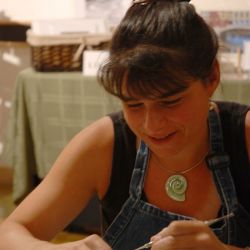Created and Sold by Lynne Meade

Small Stout Hourglass Openwork Table with Walnut Top
Price $1,800
Creation: 1-3 weeks
Shipping: FedEx 3-5 days
Estimated Arrival: May 15, 2024
| Dimensions | Weight |
|---|---|
21H x 17W in 53.34H x 43.18W cm | 20.41 kg 45 lb |
Inspired by mid-century modern design, the pierced collection is wheel-thrown and hand-pierced stoneware with a satin glaze. Small holes are created when the clay is still wet and then each hole is painstakingly enlarged and smoothed when the clay is bone dry. The tabletop is made of walnut with an oil and varnish finish for durability. The tabletop is removable for easy cleaning, but there is a walnut flange on the underside to help hold the top in place. The interplay of light and shadow, color and form complements any urban, contemporary or transitional space
• Color: White Satin, Brown
• Material: White Stoneware
• Shape: Hourglass
• Pattern: Openwork
• Top: Walnut, oil, and varnish finish
• Designed and handcrafted in Oakland, CA.
Top is removable for cleaning
DETAILS
Pierced ceramic decor, furniture, lighting and tabletop are made-to-order.
Certain styles and colors are on Quick Ship.
Custom sizes and colors are available.
Commissions for different shapes are welcome.
Lead time is 1 to 3 weeks. Custom orders can take up to 5 to 6 weeks.
• Color: White Satin, Brown
• Material: White Stoneware
• Shape: Hourglass
• Pattern: Openwork
• Top: Walnut, oil, and varnish finish
• Designed and handcrafted in Oakland, CA.
Top is removable for cleaning
DETAILS
Pierced ceramic decor, furniture, lighting and tabletop are made-to-order.
Certain styles and colors are on Quick Ship.
Custom sizes and colors are available.
Commissions for different shapes are welcome.
Lead time is 1 to 3 weeks. Custom orders can take up to 5 to 6 weeks.
Item Small Stout Hourglass Openwork Table with Walnut Top
Created by Lynne Meade
As seen in Creator's Studio, CO, CO
Have more questions about this item?